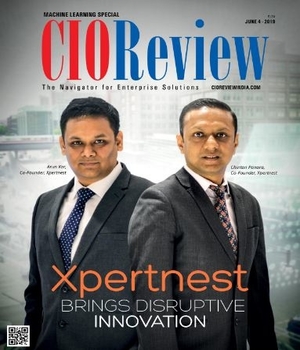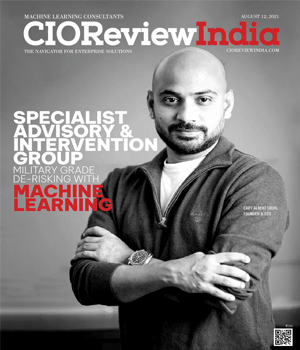
How MLOps can Boost the RoI of AI Implementation
Janifha Evangeline | Tuesday, 27 July 2021, 14:38 IST

Out of 70 leading enterprises only 15 percent have deployed Artificial Intelligence capabilities into extensive production, as per a recent study by NewVantage Partners. Artificial Intelligence that is not deployed to generate value is nothing but an expensive experiment and these are complex technical accomplishments which do not translate to Return on Investments.
MLOps lets organizations deploy, monitor, and update models in production easily by making way to Artificial Intelligence with Return on Investments. For instance, While Microsoft Azure Machine Learning, offers enterprise-grade capabilities to augment the ML lifecycle, it also authorizes both data scientists as well as developers of various skill levels to build, deploy, train, and manage models.
The Challenges
Most organizations are in a race to include ML in their applications with an idea to solve business issues that are incredibly arduous. But unfortunately, for most of them implementing ML into production has proven to be even more challenging than just searching for good data, data scientists, and determining how to train models.
Scenarios where MLOps plays a major role
Issues with deployment
Most Businesses do not realize the full benefits of Artificial Intelligence since the models are not deployed and even if they are deployed, they are not at the scale to meet the business requirements.
Issues with Monitoring
Evaluating ML model health manually is not only time-consuming but also distracts/diverts resources from model development.
Issues with lifecycle management
Although organizations can identify model decay, they may not be able to update models in production on a regular basis since the process is resource-intensive. In addition to this, there are concerns where manual code is not just brittle but also has a high potential for outages.
The Benefits of MLOps
Most of the organizations today are investing resources into MLOps intending to increase productivity and develop trusted as well as enterprise-grade models. Furthermore, the teams from innovative new businesses to large-scale public transportation departments, are utilizing or making the best use of MLOps with an aim to bring an impactful transformation or change in their respective fields.
Reducing friction between the operations and data science teams
Another interesting yet significant use of MLOps is that it facilitates bringing the workflows of ML to production by decreasing friction between the operations and data science teams. It unfolds bottlenecks, specifically those bottlenecks thatare formed in scenarios where complicated or niched ML models are siloed during the development phase. MLOps systems initiate dynamic and adaptable pipelines which enhance traditional DevOps systems intending to accommodate for unstable/ever-changing, Key Performance Indicator driven models.
Constantly measure and order models’ behaviours
MLOpsnot only supports but also optimizes on models intending to let automatic, streamlined changes. A model can travel toward processes, which accommodate for data drift without 182 days in other words 6 months of lag as well as e-mail chains. MLOp regularly measures and orders the model’s behaviour while it is in execution and hence there is a tandem sense of operation and iteration.
Adding Value to businesses
In both the private and public sectors, MLOps is bolstering the credibility, reliability, and productivity of ML development. Principally, it is enabling ML to graduate or get promoted into a respected, 1st class asset of software development.
Eric Boyd, CVP Azure AI Platform, explains that MLOps will help to accelerate the next step in creating useful machine learning. “We have heard from customers everywhere that they want to adopt ML but struggle to actually get models into production,” Boyd explains. “With the new MLOps capabilities in Azure Machine Learning, bringing ML to add value to your business has become better, faster, and more reliable than ever before.”
So, how to integrate MLOps into the production path, and what are the various end-to-end phases in MLOps? For the most part, we can imagine it in a few phases such as Collaborate, Build, Test, Release, and Monitor. While the workflow brings together the developers and data scientists into a single, automated system, it is the one,which constantly audits and manages model interpretability with time.
Enhancing the ML development practices
Most organizations are actively leveraging the powers of MLOps software already in order to maximize the performance as well as the lifespan of their models. Apart from public transportation, numerous sectors such as healthcare, engineering, etc. have implemented MLOps to enhance their ML development practices.
From models which recognize specific kinds of medication to models which predict the effects of a natural disaster such as an earthquake, autonomous systems are providing real-world impact with the help of MLOps.
Similar to successful DevOps initiatives that were leveraged prior to MLOps, the MLOps programs facilitate unifying diverse/disparate teams working on challenging and innovative projects.
Enterprises of various types are finding out the control offered by a successful MLOps strategy, which can result in more efficient, productive, and trusted models and therefore, the time has arrived to embrace the real potential of effective ML.
CIO Viewpoint
Business Analytics: Bringing new dynamics in...
By Karan Doshi, Head - IT & Strategy, Nilkamal Limited
By Vineet Bhardwaj, Head IT, Godrej Properties Limited
How AI Can Drive Socio-economic Transformation
By Sourabh Tiwari, CIO, Overseas Infrastructure Alliance (India) Pvt. Ltd
CXO Insights
By Anjani Kommisetti, Country Manager - India and SAARC, Raritan & ServerTech, brands of Legrand
Data Science and Machine Learning in FinTech
By Jainendra Kumar, Head of Global Delivery Center-India & Senior Director of Product Development Software, Diebold NixDorf
How Machine Learning is shaping the world









